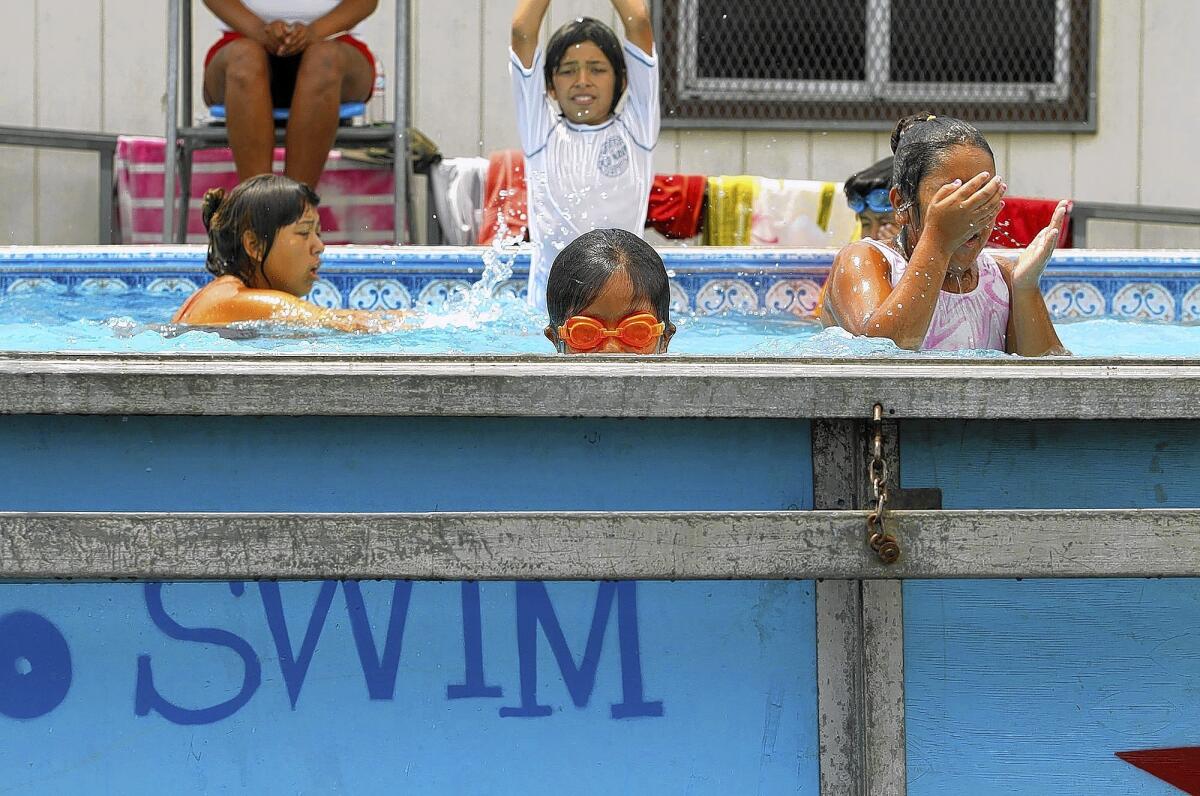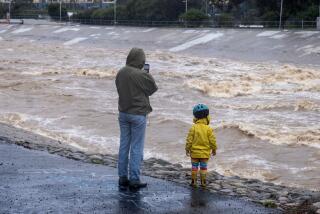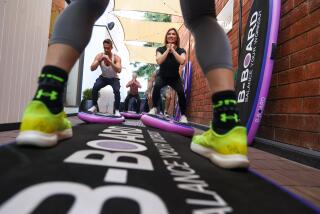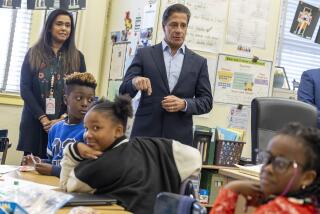LAUSD’s portable pools make the rounds for water safety

Just last week, Nathan Flores was feigning stomachaches so he wouldn’t have to swim in the 3-foot deep swimming pool, his mother said. But this week, Nathan, 5, splashes around like a koi in a pond.
Free daily lessons have taught him to be less afraid of plunging his head in the water; he’s learned to trill his lips to force the air out of his mouth in a furious flume. He’s quite taken with the balmy 84-degree pool that’s parked at Park Avenue Elementary School in Cudahy.
Yes, parked. The mobile pool is set up on the playground, part of Los Angeles Unified School District’s Beyond the Bell swim program. Up to a dozen portable pools have traveled from one campus to another every summer since 1963.
“Our goal is to spread these pools out as much as we can so we can reach other neighborhoods,” said Tim Bower, director of the Beyond the Bell program.
Because so many local students have access to beaches and private pools, L.A. Unified aims to ensure students know how to be safe and have fun in water.
A letter signed in May by Gov. Jerry Brown said that more than 60 children 5 or younger died of drowning across the state over the last five years, and that more than 700 survivors of near-drowning accidents who suffer from brain damage and other disabilities are receiving lifelong services from the California Department of Developmental Services.
The only way to save these children, Bower said, is to “make sure they can swim and make sure they can get themselves out of trouble.”
Eight pools have been in rotation among 32 campuses from June to August this year. Certified swim instructors offer free, two-week water safety and swimming technique lessons funded by government grants.
Veronica Sandoval, Nathan’s mother, said she never had the chance to learn how to swim. Because her family likes to spend time in the mountains and at the pool at her sister’s apartment, it’s an important skill to have.
“I had tried to put my son in swimming classes. I work 30 hours a week, and so it was really expensive for me,” Sandoval said. “When I heard this was coming, I was like, ‘We are definitely signing you up!’”
The program reaches up to 9,000 elementary school students like Nathan each year. Some families follow the pools as they move, Pied Piper-style.
“What do you call these people who travel around with the bands?” Bower asked.
“Groupies,” said Steven Alvarado, the program coordinator.
“Yeah. They’re the groupies,” Bower said.
Lawrence Houston, an administrator in the school system, created the portable pool program in the early 1960s, modeling it after a primary school program in England.
He designed the pool himself, making a frame of plywood and sturdy steel beams with a vinyl lining stretched across to hold the water. Houston completed it with a filtration system for sanitation, as well as a secure top to keep it covered when it’s not in use.
And that remains the design today. The 16-by-24 pool at Park Avenue Elementary is a blue oasis in an asphalt desert of basketball hoops and tetherball courts. Caution tape loops around it, encircling a mobile shower and foot bath. A lifeguard stand is fashioned out of a volleyball referee stand with a seat mounted on it.
Art Serote recalls the “old” days when they instead used chairs stacked on tables as their perches. Now a retired teacher, he spent more than 40 summers with the program as a swim instructor.
“I’ve run into some principals and assistant principals who were in the program when they were kids,” he said.
Between 8:30 a.m. and 3:30 p.m., there’s a continuous stream of 30-minute swimming classes for different experience levels. Some students are learning how to hold their breath and others are learning new strokes.
“Star, rocket, monkey! Star, rocket, monkey!” three instructors boom to their students, describing the different positions for a successful elementary backstroke.
To date, there have been no serious accidents or injuries. The classes give the students courage to try things they previously feared and to improve their water skills. “Freestyle” and “backstroke” are now part of their vocabulary, and they know to walk instead of run around the pool.
Signs convey such rules as, “No dunking,” “No shoving” and “No gum-chewing.” Pool manager Ruby Meneses relays some verbal ones, floating easily between English, Spanish and sign-language.
“I want you to do two things. One: Try your best. And two: Never compare yourself to others,” Meneses instructs. “There’s no winner; there’s no loser. As long as you try your best, that’s all that matters.”
After a satisfying practice, 12-year-old Leslie Lopez emerges triumphant. She stays to watch Nathan, her cousin, finish.
“Before, I could just do the doggy paddle. Now, I feel more confident in myself knowing that I can do this,” Leslie said. “I feel free.”
Summer’s days are numbered, and so are the portable pools’. It’s as if the circus is leaving town. Crews are rolling away the vinyl and packing the plywood painted with colorful stars into semi-trucks, headed for storage. The students look forward to being the ringmasters of their own aquatic adventures when the pools return to campus next summer.
sara.hayden@latimes.com
Twitter: @haydensaraa
More to Read
Start your day right
Sign up for Essential California for news, features and recommendations from the L.A. Times and beyond in your inbox six days a week.
You may occasionally receive promotional content from the Los Angeles Times.






